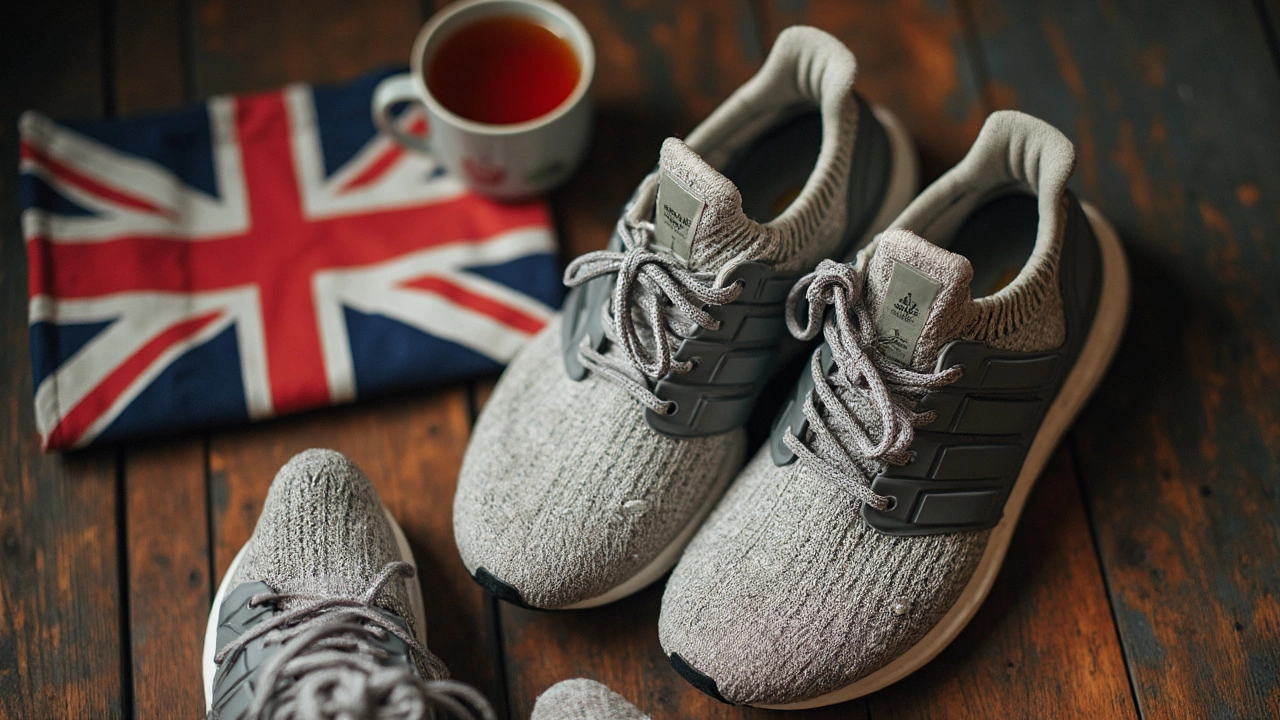Why Is Ultraboost So Good? The Secret Sauce Behind These Running Shoes

People don’t just like Ultraboost shoes, they’re borderline obsessed. Some walk so much in them that they’ll swear they haven’t touched any other sneakers since they got their first pair. What makes them so addictive?
The biggest thing people talk about is comfort. This isn’t just marketing hype—Ultraboost’s signature foam really does offer a crazy level of squish and support. You notice it right away, whether you’re out for a run, standing in line, or just taking the dog out.
But there’s more going on underneath. Adidas packed these shoes with tech, but didn’t make them look like gadgets. That means you get performance and style in one package—no trading off substance for looks.
- The Magic of Boost Foam
- Design That Works for Real Life
- Ultraboost vs the Competition
- Tips to Maximize Comfort and Life
The Magic of Boost Foam
If you google "Ultraboost secret," you'll keep seeing the words “Boost foam” pop up. This squishy, bouncy stuff changed the sneaker game. Adidas actually worked with BASF, a legit chemical company, to create those small white pellets you see packed in the sole. When they mash thousands of them together, you get that famous Boost midsole—super soft, but not mushy, and way more springy than standard EVA foam (which was the go-to in running shoes for years).
Some real-world numbers: Adidas says Boost gives you up to 20% more energy return than regular soles. That means every step pushes you forward with less wasted effort. If you’re running, this isn’t just marketing speak—you actually feel a little rebound, kind of like a mini trampoline under your foot.
| Boost Foam vs EVA Foam | Boost | EVA |
|---|---|---|
| Energy Return | Up to 80% | About 60% |
| Durability | High | Can flatten over time |
| Feel | Soft but springy | Soft, less bounce |
It’s not just hype. Here’s what sneaker reviewer Bryan Hinkle said after testing,
“With Boost, there’s less pounding on your legs and more ‘roll’ in your stride. The cushioning doesn’t give up, even on long days.”
You’ll also notice Boost foam stays cushy even in cold weather, when other soles tend to turn hard and lose their bounce. So whether you’re racing, training, or just living your daily life, that comfort sticks around.
The best part? It’s not a one-and-done thing. People report their Ultraboost pairs keep their comfy feel for a lot longer than basic runners, so you really get your money’s worth.
Design That Works for Real Life
With Ultraboost, it’s not just about looking good on a run. These shoes have a design aimed at actual, everyday life. The Primeknit upper, for example, hugs your foot but stretches in the right spots, so whether your feet swell on a flight or you’re hustling around the office, they stay comfortable. No pointy toes, no weird pinch zones—just a sock-like fit that makes them super easy to wear for hours.
One underrated detail is the molded heel counter. It looks simple, but it holds your heel steady without digging in or causing blisters. That’s clutch if you’re logging long miles or just walking all over town. Add in a flexible outsole made from Continental™ rubber and you get solid grip even if you step out for a rainy coffee run. You’re not tiptoeing around puddles anymore.
The design also works for all sorts of outfits. You’ll see people at marathons in them, but also at brunch or even in offices with a casual dress code. Pretty wild for a performance shoe series.
- Ultraboost's design is lightweight, so it doesn’t drag you down at any point during the day.
- The shoe's seamless upper means less chance of rubbing or blistering compared to clunky stitched trainers.
- The famous midsole gives instant energy return, making it easier to power through long shifts on your feet.
For reference, Adidas launched the first Ultraboost in 2015. Some models since then got even lighter and more breathable, perfect for summer days or sweaty runs. If you’re swapping out old running shoes because they felt hot and heavy, these will feel like a major upgrade.

Ultraboost vs the Competition
Let’s get real: there are tons of good running shoes out there. So, what makes Ultraboost really stand out compared to big names like Nike Pegasus, Brooks Ghost, or ASICS Gel-Nimbus?
The main thing that sets Ultraboost apart is the Boost midsole. It’s packed with thousands of tiny capsules that actually compress and bounce back with each step. This isn’t just cool tech talk—you can feel it every time you walk or run. Nike’s React foam comes close in bounce, but most runners say it’s not as soft or cushy underfoot as Boost. Brooks offers great shock absorption, but their midsoles feel a bit stiffer if you’re in them all day. As for ASICS, the Gel setup is legendary for long runs, but it can feel heavier and bulkier than Ultraboost.
Here’s a quick side-by-side so you can get a sense of where Ultraboost lands:
| Shoe | Best For | Midsole Feel | Weight (Men's 9) | Price Range (USD) |
|---|---|---|---|---|
| Adidas Ultraboost | Everyday, soft runs, casual | Super soft, bouncy | 10.9 oz | $190–$200 |
| Nike Pegasus | Training, speedwork | Responsive, a bit firmer | 9.8 oz | $100–$130 |
| Brooks Ghost | Daily mileage, comfort | Balanced, slight bounce | 10.1 oz | $140–$150 |
| ASICS Gel-Nimbus | Long distance, max cushion | Soft, thick, a bit heavy | 10.5 oz | $160–$180 |
Another neat thing is style. Ultraboost is one of the few performance shoes that looks good with jeans, joggers, or even regular clothes. Try that with most other running shoes—they’ll almost always look a bit awkward outside the gym.
But there are a couple of drawbacks. Ultraboosts aren’t the lightest, so if you’re racing or need maximum speed, you’ll want something slimmer. They also come at a higher price tag, so you’re paying for both tech and the brand.
Bottom line? If you want a shoe that mixes comfort, bounce, and style, the Ultraboost easily outshines a lot of the competition—especially for people on their feet for hours or switching between runs and regular life.
Tips to Maximize Comfort and Life
There’s a reason you see people rocking their Ultraboost for years. These shoes last when you show them some love—and that comfort you felt out of the box doesn’t have to fade too quickly. Here’s how to keep that “new shoe” feeling for as long as possible:
- Rotate Your Shoes: Don’t just wear your Ultraboost every single day, especially if you’re running a lot. Switch them out with another pair every couple of days. This gives the foam time to bounce back and keeps it from breaking down too fast.
- Dry Them the Right Way: Got caught in the rain, or your shoes got sweaty? Never toss them in the dryer—heat can ruin the Boost foam and warp the upper. Instead, pull out the insoles, stuff them with newspaper, and let them air dry indoors.
- Clean Them Regularly: Mud and grime can make your shoes stiff if you leave it for too long. Use a soft brush with a little warm water and mild soap. Stay away from harsh chemicals, which can eat at the materials and glue.
- Check the Wear: Even the comfiest running shoes wear out. Keep an eye on the soles. If they’ve gone bald, or the foam feels dead and flat, it’s time to think about a new pair. Most folks get 300-500 miles out of an Ultraboost with regular use.
According to ESPN running gear expert Jane Dillard,
“Proper shoe care isn’t just about keeping them looking fresh—little habits like rotating and hand cleaning can literally add months to the lifespan of top models like the Ultraboost.”
If you’re curious about how the Ultraboost stacks up against other shoes, here’s a quick mileage comparison for average lifespan:
| Shoe Model | Average Mileage |
|---|---|
| Ultraboost | 400 miles |
| Adidas Adizero | 300 miles |
| Nike Pegasus | 350 miles |
| Brooks Ghost | 400 miles |
One last tip: store your Ultraboost in a cool, dry spot. The less sun and heat they see, the longer they’ll keep that signature bounce. Treat them right, and they’ll treat your feet right in return.
